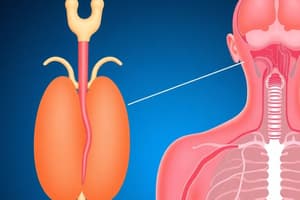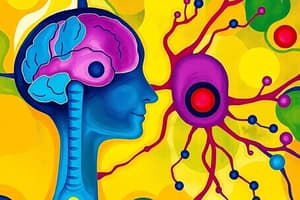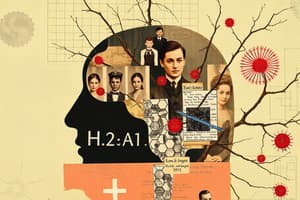Podcast
Questions and Answers
What is the role of the signal sequence in peptide hormone synthesis?
What is the role of the signal sequence in peptide hormone synthesis?
- It prevents the hormone from being cleaved into active forms.
- It activates the hormone immediately.
- It directs the preprohormone into the endoplasmic reticulum. (correct)
- It helps transport the hormone into the target cell.
Where do enzymes chop the prohormone to create active peptides?
Where do enzymes chop the prohormone to create active peptides?
- In the plasma membrane
- In the Golgi complex (correct)
- In the endoplasmic reticulum
- In the cytoplasm
Which of the following statement is true regarding peptide hormones?
Which of the following statement is true regarding peptide hormones?
- They can easily cross the plasma membrane of target cells.
- They are synthesized directly in the secretory vesicles.
- They require surface membrane receptors to exert their effects. (correct)
- They are always in an active form when released into circulation.
Which structure contains the preprohormone after it is synthesized on ribosomes?
Which structure contains the preprohormone after it is synthesized on ribosomes?
What happens to the contents of secretory vesicles during hormone release?
What happens to the contents of secretory vesicles during hormone release?
What triggers the secretion of insulin from pancreatic beta cells?
What triggers the secretion of insulin from pancreatic beta cells?
What does insulin do to target tissues?
What does insulin do to target tissues?
Which feedback mechanism ends the release of insulin?
Which feedback mechanism ends the release of insulin?
What is one source of signals that can also trigger insulin secretion?
What is one source of signals that can also trigger insulin secretion?
What size is the pituitary gland in relation to a common object?
What size is the pituitary gland in relation to a common object?
What is the primary reason steroid hormones are usually bound to carrier proteins in the blood?
What is the primary reason steroid hormones are usually bound to carrier proteins in the blood?
Which of the following hormones is derived from tryptophan?
Which of the following hormones is derived from tryptophan?
Why are steroid hormones considered to be made on demand?
Why are steroid hormones considered to be made on demand?
From which parent compound are all steroid hormones derived?
From which parent compound are all steroid hormones derived?
How do catecholamines relate to tyrosine in terms of their chemical structure?
How do catecholamines relate to tyrosine in terms of their chemical structure?
What is the main reason steroid hormones are not stored in endocrine cells?
What is the main reason steroid hormones are not stored in endocrine cells?
What role do carrier proteins play for steroid hormones in the bloodstream?
What role do carrier proteins play for steroid hormones in the bloodstream?
Which hormones are classified as amino acid-derived or amine hormones?
Which hormones are classified as amino acid-derived or amine hormones?
What term describes the substances that influence cell growth and division currently being studied as potential hormones?
What term describes the substances that influence cell growth and division currently being studied as potential hormones?
How do many growth factors primarily act in the body?
How do many growth factors primarily act in the body?
Why is it important for hormone activity to be of limited duration?
Why is it important for hormone activity to be of limited duration?
What was the historical significance of cholecystokinin (CCK) after its discovery?
What was the historical significance of cholecystokinin (CCK) after its discovery?
In what two contexts can a single molecule act as both a hormone and a paracrine signal?
In what two contexts can a single molecule act as both a hormone and a paracrine signal?
What is the role of insulin in glucose metabolism?
What is the role of insulin in glucose metabolism?
Which of the following does NOT describe a function of CCK?
Which of the following does NOT describe a function of CCK?
What complicates the classification of signal molecules in the body?
What complicates the classification of signal molecules in the body?
What is the role of aromatase in hormone synthesis?
What is the role of aromatase in hormone synthesis?
Which hormone is directly derived from dehydroepiandrosterone (DHEA)?
Which hormone is directly derived from dehydroepiandrosterone (DHEA)?
What is the function of 21-hydroxylase in steroid synthesis?
What is the function of 21-hydroxylase in steroid synthesis?
Which of the following compounds is derived from Cholesterol?
Which of the following compounds is derived from Cholesterol?
Which hormone is considered an intermediate compound in the steroidogenesis pathway?
Which hormone is considered an intermediate compound in the steroidogenesis pathway?
In the steroid synthesis pathway, which enzyme is responsible for converting Androstenedione to Estrone?
In the steroid synthesis pathway, which enzyme is responsible for converting Androstenedione to Estrone?
What type of compound is DHT in relation to Testosterone?
What type of compound is DHT in relation to Testosterone?
Which of the following is NOT a direct product of cholesterol metabolism?
Which of the following is NOT a direct product of cholesterol metabolism?
Which pathway is regulated by the enzyme aromatase?
Which pathway is regulated by the enzyme aromatase?
Which of these hormones is primarily produced in the adrenal cortex?
Which of these hormones is primarily produced in the adrenal cortex?
Flashcards are hidden until you start studying
Study Notes
Hypothalamic Hormones and Growth Factors
- In the 1970s, hypothalamic hormones were referred to as "releasing factors" and "inhibiting factors," distinguishing them from traditional hormones.
- Growth factors are being researched to determine if they qualify as hormones; these substances influence cell growth and division.
- Many growth factors operate locally, exhibiting autocrine or paracrine signaling, as opposed to widespread hormonal circulation.
- Eicosanoids are lipid-derived signaling molecules with a classification that can vary based on secretion location (hormone vs. autocrine/paracrine).
Cholecystokinin (CCK)
- CCK was initially identified as an intestinal hormone responsible for gallbladder contraction in the 1920s.
- Discovered in the mid-1970s, CCK was also found in the brain, where it functions as a neurotransmitter or neuromodulator.
Cellular Mechanisms of Peptide Hormone Action
- Peptide hormones are lipophobic and bind to cell surface membrane receptors, preventing their entry into target cells.
- Peptide hormones are synthesized as inactive preprohormones and undergo processing in the endoplasmic reticulum (ER) and Golgi complex.
- Active hormones are released through exocytosis once cleaved from prohormones within secretory vesicles.
Transport and Half-Life of Steroid Hormones
- Steroid hormones, derived from cholesterol, are lipophilic and mostly bound to protein carriers in plasma, enhancing their stability.
- Binding protects steroid hormones from degradation and extends their half-life; for example, cortisol is transported this way.
- Most steroid hormones are synthesized in the adrenal cortex or gonads and released upon demand, not stored in cells.
Amino Acid-Derived Hormones
- Amine hormones are derived from tryptophan or tyrosine; notable examples include melatonin (from tryptophan) and catecholamines/thyroid hormones (from tyrosine).
- Catecholamines are modified from a single tyrosine molecule, while thyroid hormones consist of two tyrosine molecules bonded with iodine.
Insulin Secretion and Blood Glucose Regulation
- Pancreatic beta cells monitor blood glucose concentrations; insulin is secreted when levels rise after a meal.
- Insulin promotes glucose uptake and metabolism in target tissues, decreasing blood glucose levels and providing negative feedback to regulate further insulin secretion.
- Insulin secretion can also be stimulated by neural signals or hormones from the digestive tract in response to food.
The Pituitary Gland
- The pituitary gland is composed of two fused glands, functioning as a major endocrine center that integrates signals for hormone release.
- Its size is comparable to a lima bean, and it plays a crucial role in regulating hormones connected to several physiological processes.
Studying That Suits You
Use AI to generate personalized quizzes and flashcards to suit your learning preferences.




